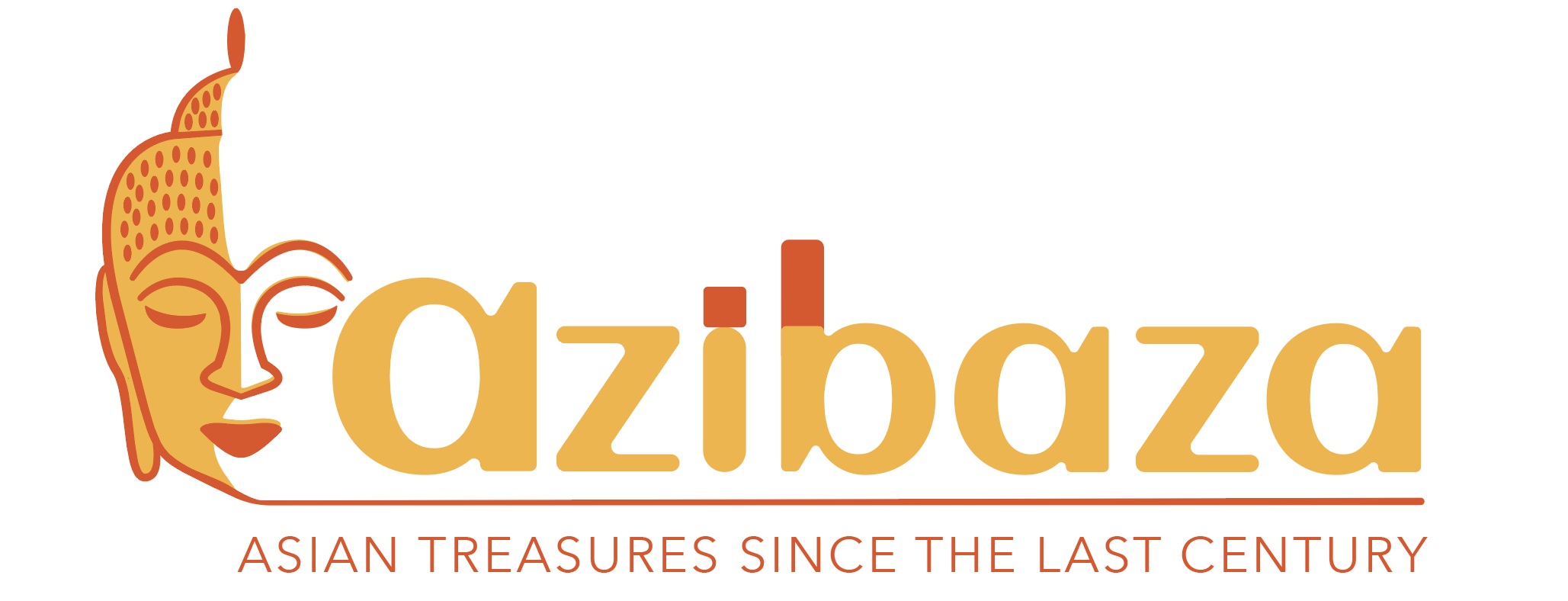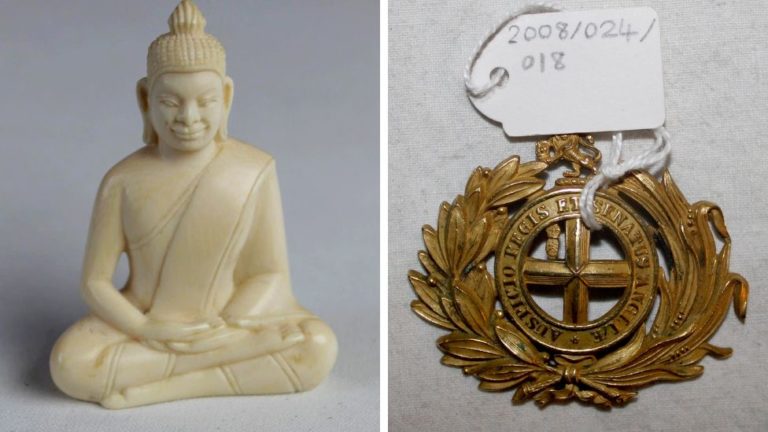Torrential rain did not keep them away. Well before the opening hour of 9 a.m. on June 8, more than 30 people were lined up at the Turner Lynch Campus Center at Oglethorpe University in Brookhaven. Juggling umbrellas, they carried boxes, shouldered backpacks and pulled suitcases holding family heirlooms and antiques in the hopes of discovering hidden treasures.
They had braved the weather for “Hidden Treasures: Unveiled,” an appraisal event organized and hosted by Oglethorpe University Museum of Fine Art (OUMA). And some surprise treasures were discovered, ranging from a centuries-old Buddha bust to a book with a dark past.

Ellen Kierr Stein looks at the bust of Buddha she had appraised and then donated to the Oglethorpe University Museum of Fine Art. (Phil Mosier)
Specialists from Hindman, an internationally known auction house were on hand to appraise items. Five experts were at stations for Fine Art, Decorative Art, Asian Art, Jewelry and Books and Manuscripts. Appraisal fees went to help fund OUMA, and a portion of proceeds from any items discovered at the event and auctioned by Hindman will go to the museum as well.
Attendees came from all parts of metro Atlanta and as far away as Dahlonega and Cartersville. Two hundred people brought their treasures and 300 items were appraised, reported museum director Elizabeth Peterson, director of OUMA.
Jonathan Dickson navigated his way from East Cobb County with several heirlooms in tow, including a painting, porcelain pieces, German beer steins and a large book of Goethe’s writing. They are remnants of his father’s estate, he said. Most of them had been handed down by Dickson’s grandfather, who had lived in New York, Florida and Germany. His first stop was the Fine Art table, staffed by Kate Stamm, Hindman’s Fine Art specialist for the Southeast region.
Dickson unveiled a large full-length portrait of two young girls dressed alike in red, arms entwined. He had virtually no information on the painting, not even a title, only the artist’s last name, Hoffman.
The title may never be known, but Stamm dated the work in 1865. The piece had only minor flaws. She researched the painting after the event and sent Dickson a report four days later, identifying the artist as George C. Hoffman.
“The estimated value is in the low thousands.” said Dickson. “We will keep it as a family heirloom.” The mystery remains whether those children are on his family tree.
Dickson also visited the Decorative Art station with his porcelain pieces and German beer steins. The popular stop was manned by expert Jon King, Hindman’s senior consultant for the Southeast region, who has been in the field since the early 1980s, King has overseen collections from the estates of noted celebrities and has worked with the PBS series “Antiques Roadshow” and HGTV’s “Appraise It!”
The heirlooms Dickson laid out at the Decorative Art table are not of much value, he found out, but he said he learned some interesting information about them. His final stop was the Books and Manuscripts table, staffed by Gretchen Hause, who is a specialist in Hindman’s Fine Books and Manuscripts department.
The hefty book of Johann Wolfgang von Goethe’s writings was apparently given to Dr. Wilhelm Frick by the city in Germany where he lived, Hause told Dickson. Frick was Adolph Hitler’s minister of interior for 10 years and was hanged for war crimes. Another mystery for his family: Dickson said he doesn’t know how the book came into his grandfather’s possession. “Its is not entirely a happy story, but certainly a fascinating one.”

From left, Gary and Gloria Kubick present a glass lampshade to appraiser Jon King. The Kubicks were disappointed to learn the item was not a product of Tiffany. (Phil Mosier)
Gloria and Gary Kubik from Johns Creek set their large carton on the Decorative Art table with hopeful expectations. They lifted out a large Tiffany-style lamp shade that had long been in the office of Gary Kubik’s grandfather. His grandfather had shipped the lamp from Connecticut so the couple could bring it to the event.
“We’ve always been told it is probably a Tiffany lamp,” Gary Kubik said.
Specialist Jon King examined the shade carefully. Regretfully, he gave the Kubiks the news. It is a 1920s lamp, he told them. “But it is not an original Tiffany. Many Tiffany-style lamps and shades were made then and still are,” he said. Although there were other clues, the most obvious was the lack of a Tiffany signature or any indication that it was made in the Tiffany studio.
The Kubiks took the news well and said they would not be taking an extended vacation or retiring any time soon, but that the appraisal experience was “really fun.”
Ken Moorman of Brookhaven, accompanied by family friend, Trish Percival, stepped to the Asian Art station. Unwrapping two panels of Asian paintings, he explained to specialist Annie Wu that they had been owned by his wife’s aunt in California.
“All I ever heard about them is that they are Japanese,” he told Wu.
“No, they are Chinese, done between 1850 [and] 1870 and had been painted at a center in Jing De Zhen in central China,” said Wu. She explained that in the 19th and 20th centuries, scholars were invited to the center to paint works of art, mainly for export.
The delicate, detailed porcelain paintings on individual tiles are of classic Chinese scenes and people. Few of the scholars became well-known, although each painting is signed with the artist’s signature “chop,” or seal, in red. The writing on the paintings are descriptions or poems about the scenes, and Wu offered to have them translated for Moorman.

From left, Trish Percival and Ken Moorman listen to appraiser Annie Wu’s explanation of Chinese artworks that Moorman owns. (Phil Mosier)
“The paintings and condition of the panels are important, and it is rare to find them in as good a condition as yours. Typically, they came in a set of four panels, which would likely be valued in the high thousands at auction,” said Wu, adding, “The market for Chinese art buyers is very active right now.”
Ellen Kierr Stein remembered her Buddha bust being a fixture in her parents’ homes as far back as the 1960s. It was part of an eclectic collection of artifacts from their worldwide travels, she recalled.
Wu, at the Asian Art station, filled in some details. The Buddha bust is a bronze Thai piece from the 16th or 17th century and is “very good condition,” she said.
“Buddha is an iconic image in Asian culture and the expression on his face is very important. This Buddha has a calm, benevolent expression, as is fitting.”
A highlight of the day was Kierr Stein’s surprise, on-the-spot donation of the Buddha bust to OUMA, made with her sister, Susan Kierr in memory of their parents, J.N. and Raymond Kierr.
“We were thrilled,” said John Tilford, OUMA’s curator of collections. “It’s a major contribution to our permanent collection and a wonderful addition to our Asian collection.”
–Judith Schonbak




